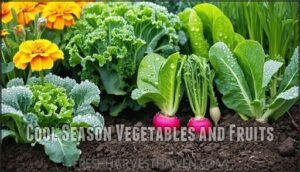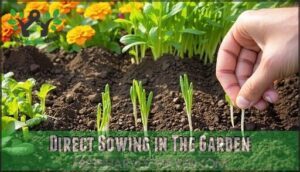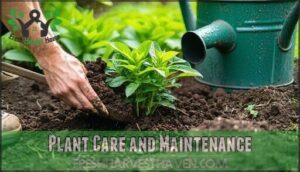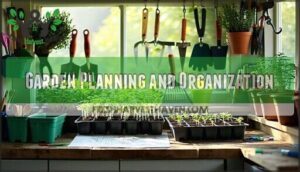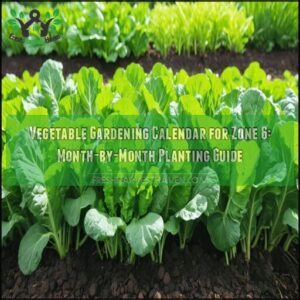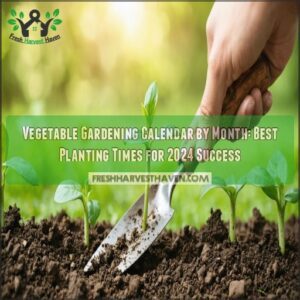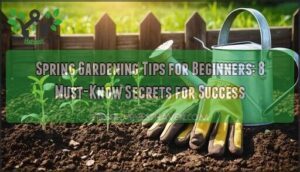This site is supported by our readers. We may earn a commission, at no cost to you, if you purchase through links.
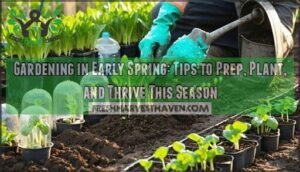 Gardening in early spring is all about setting the stage for success. Start by clearing winter’s leftovers—remove debris, dead plants, and weeds to give your garden a fresh start.
Gardening in early spring is all about setting the stage for success. Start by clearing winter’s leftovers—remove debris, dead plants, and weeds to give your garden a fresh start.
Check for winter damage on beds, fencing, or tools, and watch for signs of critter activity. Next, focus on soil prep: mix in compost or organic matter to boost nutrients and create a fluffy, plant-friendly texture.
Once the soil’s ready, plant cool-season veggies like spinach or peas, and start herb seeds indoors. Keep an eye on frost dates to protect tender plants.
A well-prepped garden now pays off all season!
Table Of Contents
- Key Takeaways
- Spring Garden Preparation
- Soil Preparation Techniques
- Early Spring Planting Guide
- Plant Care and Maintenance
- Garden Planning and Organization
- Frequently Asked Questions (FAQs)
- When should I start my garden in the spring?
- What is the gardening 3 year rule?
- What is the most common mistake of first time gardeners?
- What vegetables can I plant earliest in the spring?
- Is April too early to plant a garden?
- What seeds can you plant in early spring?
- How do I attract pollinators to my garden?
- What are tips for building raised garden beds?
- How can I prevent pests in early spring?
- What tools are essential for spring gardening?
- Conclusion
Key Takeaways
- Clear debris, dead plants, and weeds to give your garden a fresh start and maintain hygiene.
- Prep your soil with compost or organic matter to boost nutrients and improve texture.
- Plant frost-tolerant crops like spinach, peas, and kale early to maximize the season.
- Monitor frost dates and protect tender plants with covers or proper watering techniques.
Spring Garden Preparation
Start your spring garden preparation by inspecting for winter damage, cleaning up debris, and tackling any weeds.
Inspect, clean, and conquer weeds—lay the groundwork for a vibrant, thriving spring garden!
Check hardscaping, watch for animal burrows, and get your space ready for a fresh season of growth.
Inspecting for Winter Damage
Start your spring garden prep with a thorough garden inspection.
Check for plant cold damage, woody plant issues, or protective mulch damage from winter. Look for hardscape winter shifts, like bowed patios or cracked paths. Spot animal winter damage, such as burrows or chewed branches.
Pruning spring plants early helps recovery, guaranteeing your garden thrives. Remember to consult a spring garden maintenance checklist to guarantee no task is overlooked.
Cleaning Up Debris and Weeds
After inspecting for winter damage, it’s time to tackle spring garden cleanup.
Clearing debris and weeds boosts garden hygiene and sets the stage for healthy growth.
- Weed Identification: Pull weeds early to prevent spreading.
Effective gardening requires proper weed recognition.
- Debris Disposal: Remove dead leaves and branches, adding them to your compost pile.
- Tool Maintenance: Sharpen tools for efficient garden maintenance.
Keep mulch even to protect soil.
Preparing Hardscaping for Spring
Spring’s a perfect time to refresh garden structures.
Repairing retaining walls and leveling pathways can prevent future mishaps. Deck maintenance and applying fresh stain keep spaces sturdy and inviting.
Don’t forget trellis restoration—vital for supporting plants. A thorough furniture cleaning preps for outdoor lounging, while pond cleanup guarantees water features sparkle, adding charm to your hardscaping and garden beds.
Checking for Animal Burrows and Damage
Keep an eye out for animal burrows and other signs of damage, like uprooted plants or gnawed bark.
These pests could harm your garden’s growth. Identify their entry points and use humane deterrents like motion-activated sprinklers.
Repairing damage early prevents bigger issues later. Garden protection includes maintaining fences, applying natural repellents, and staying vigilant against garden wildlife while fostering a balanced ecosystem.
Garden protection is crucial, and using methods like motion-activated sprinklers can help.
Soil Preparation Techniques
Getting your soil ready is the most important step for a thriving spring garden.
Preparing soil properly lays the foundation for vibrant, thriving plants and a healthy, productive garden all season long.
By adding organic matter, mixing in compost, and creating nutrient-rich seed beds, you’ll give your plants the best chance to grow strong and healthy.
Adding Organic Matter and Fertilizers
Healthy soil is key to a thriving spring garden.
Enrich it with organic materials like compost or well-rotted manure for better soil health.
Don’t skip soil testing—it helps guide fertilizer application and avoid over-fertilization.
Earthworms will thank you and boost your garden’s vitality!
Consider garden compost options for ideal results.
- Add compost types fit for your plants.
- Use manure as a natural nutrient boost.
- Encourage earthworm benefits naturally to create a thriving garden.
Mixing Compost Into Garden Soil
Compost supercharges soil health, boosting nutrient availability and water retention.
Mix two inches of compost into six inches of garden soil for improved soil structure. This step jumpstarts soil preparation for spring, encouraging earthworm activity and aeration.
Organic materials in compost enrich your garden, ensuring plants thrive. Don’t rush—work gently to let nutrients bind naturally with the soil, which is crucial for soil preparation and overall soil health.
Creating Optimum Seed Beds
To create optimum seed beds, start by loosening your garden soil down six inches for better seed spacing and germination rates.
Add organic amendments like compost to balance soil nutrients. Mix organic matter evenly to enhance soil composition.
During soil preparation this spring, make certain proper watering techniques, keeping soil moist but not soggy—ideal for seed bed preparation that thrives.
Early Spring Planting Guide
Start your early spring planting by focusing on hardy, cool-season crops that thrive in chilly conditions, like peas, lettuce, and spinach.
Use this time to prepare for unpredictable weather, ensuring soil is thawed and ready for seeds or transplants.
Cool Season Vegetables and Fruits
Cool season vegetables thrive in early spring gardening, tolerating light frost while delivering fresh produce.
Variety selection matters—peas, radishes, and kale are perfect examples of frost-tolerant crops.
Stick to the planting timeline; sow seeds once the soil thaws.
Rotate crops yearly to boost soil health and use basic pest control strategies to keep your vegetable planting productive and rewarding.
Employing companion planting methods can further enhance growth and deter pests, making it a key part of successful and productive gardening with companion planting.
Planting Herbs and Starting Seeds Indoors
Starting seeds indoors is a cornerstone of early spring gardening.
Use a fine-textured potting mix for successful indoor seed starting, ensuring proper moisture retention.
For herbs, like basil or dill, good Indoor Lighting matters—place trays by a sunny window or use grow lights.
To improve germination, consider soaking seeds beforehand.
Monitor seedling care, watering gently, and plan transplant timing to ease herbs into outdoor beds as temperatures rise.
Direct Sowing in The Garden
If you’ve started seeds indoors, direct sowing comes next for cool-season crops. Early spring gardening favors root veggies like radishes and carrots.
Follow seed depth guidelines, guaranteeing good soil contact. Use row marking for neatness, and keep rows moist for germination.
Consider companion planting basics to maximize your garden’s potential.
Succession planting every two weeks guarantees steady vegetable planting and harvests, keeping your garden productive and fresh!
Planning for Thaws and Freezing Temperatures
When early spring gardening, frost protection is key to keeping plants healthy.
Use garden covers to manage microclimates and shield frost protection plants. Check frost dates and thaw timing to avoid premature planting.
Moist soil retains warmth, so water management matters. Guarantee plant hardiness by choosing resilient varieties that thrive in your area’s conditions, and you’ll be prepared for unexpected chills.
Plant Care and Maintenance
Taking care of your plants in early spring sets the foundation for a vibrant garden. Practice smart watering techniques, like soaking soil deeply but less often, to promote strong root systems.
Keep pests in check by inspecting leaves regularly and removing any unwanted visitors by hand when possible. Disease prevention starts with maintaining proper air circulation, so don’t overcrowd plants.
Apply mulch evenly to regulate soil temperature, lock in moisture, and reduce weed growth. Pruning strategies are critical—trim off dead or damaged stems while leaving the healthy growth intact.
Spring garden maintenance also benefits from using slow-release garden fertilizers, ensuring nutrients are available over time. These spring garden tips make plant care effective and keep your garden thriving.
Garden Planning and Organization
Start your garden planning by identifying your zone and the last frost date, so you know when and what to plant.
Organize your beds and schedule tasks to keep everything running smoothly as the season progresses, this includes complete concepts to ensure a successful garden.
Determining Garden Zones and Last Frost Dates
To plan your spring gardening, know your Hardiness Zone and how garden microclimates impact planting.
Frost prediction tools help pinpoint your last frost date, guiding planting schedules for different crops.
Regional variations, like sheltered spots or open fields, influence frost risk.
Understanding garden zones guarantees plants thrive, even in unpredictable spring weather, and helps you tailor choices for success.
Planning for Garden Bed Cleanup and Maintenance
As part of your spring garden checklist, focus on garden bed cleanup for a thriving start.
Begin with debris removal to clear old leaves and winter damage. Evaluate mulch management to maintain even levels and prevent erosion.
Perform a hardscape assessment to spot frost heaves or rotten spots. Don’t forget burrow prevention—check for unwelcome critters disrupting soil preparation spring activities.
Creating a Gardening Schedule and Timeline
Building a spring garden schedule helps order tasks and maximize your time.
Start with succession planting and indoor seed starting. Track hardening off seedlings and set your transplanting timeline.
Use a checklist for garden planning and seasonal crop rotation.
| Task | Timeline | Notes |
|---|---|---|
| Seed Starting | Late February | Use warm windowsills or trays. |
| Succession Planting | Mid-March | Plan for harvest overlap. |
| Transplanting | Late April | Harden off seedlings first. |
Preserving Beneficial Insects and Soil Health
Preserving beneficial insects and soil health is key for a thriving garden.
Focus on these practices:
- Leave wildflower patches as insect habitats.
- Use cover cropping to enrich garden soil.
- Reduce tillage to protect soil microbes.
- Rely on natural pest control, like ladybugs and lacewings.
- Rotate crops yearly for disease prevention.
Healthy garden soil means healthier plants and fewer pests naturally, which is the result of maintaining soil health.
Frequently Asked Questions (FAQs)
When should I start my garden in the spring?
Start your garden when the soil’s workable, not muddy or frozen.
Cool-season veggies like peas, spinach, and broccoli thrive early.
Aim for late February to April, depending on frost dates in your area.
What is the gardening 3 year rule?
The gardening 3-year rule means rotating your crops each year by planting them in different areas.
This prevents soil nutrient depletion, reduces pests or diseases, and keeps your garden thriving over time.
What is the most common mistake of first time gardeners?
Planting seeds of excitement without preparation is a common trap.
You might skip soil testing, overcrowd plants, or overlook sunlight needs.
Always research, plan, and start small to nurture both your garden and confidence.
What vegetables can I plant earliest in the spring?
Peas, spinach, arugula, and kale are your go-to early spring veggies.
They’re frost-tolerant, thrive in cool weather, and can handle a little chill.
Plant these as soon as the soil is workable for the earliest harvests.
Is April too early to plant a garden?
April’s perfect for many garden tasks.
You can plant frost-tolerant veggies like peas, carrots, and spinach.
Prepare soil, prune shrubs, or even start flower seeds indoors.
Just watch for lingering frost before planting tender crops.
What seeds can you plant in early spring?
Time to roll up your sleeves!
In early spring, plant frost-tolerant seeds like peas, spinach, kale, carrots, radishes, and lettuce.
They thrive in the chill, giving you a jumpstart on an abundant garden.
How do I attract pollinators to my garden?
Add diverse, native plants to your garden for continuous blooms, provide water sources, and skip pesticides.
Include bright flowers like lavender or sunflowers, and create cozy habitats.
Pollinators will buzz in happily before you know it, surrounded by sunflowers!
What are tips for building raised garden beds?
Start by choosing durable, untreated wood, metal, or stone for your beds.
Make certain proper drainage and level ground.
Fill with high-quality soil and compost.
Place them in sunny spots for ideal growth.
How can I prevent pests in early spring?
Did you know 90% of garden pests hatch in spring?
To stop them, clear winter debris, rotate crops, and plant pest-repelling herbs like basil or thyme.
Inspect plants often for early signs of trouble.
What tools are essential for spring gardening?
You’ll need gloves, pruning shears, a spade, rake, and trowel for planting and cleanup.
Add a hose, wheelbarrow, and soil tester for efficiency.
These basics handle most tasks and keep gardening enjoyable.
Conclusion
A little effort now can lead to a garden bursting with life later.
By focusing on gardening in early spring, you create the foundation for a thriving season.
Clear debris, prep the soil, and start planting cool-season veggies or seeds indoors.
Don’t forget to watch for frost dates and protect tender plants.
With these steps, your garden will be ready to flourish, offering beauty and fresh produce to enjoy throughout the growing season.
Happy gardening!
- https://www.youtube.com/watch?v=A_9l1ku58rs&list=PLOCd6lFGB16zxYhzGxrZYxgMzpmDhtNqr&index=7
- https://www.pinterest.com/provenwinners/perennials-for-spring/
- https://www.ifa.coop/ifa100000955
- https://youtube.com/shorts/Fl7F8A4AUH4
- https://learn.squarefootgardening.org/p/introductory-square-foot-gardening-course?_ga=2.251504582.1564120819.1685970964-805445608.1677701915





